Monodonts are a major group of plicozoa. They are characterized by a piercing rostrum, a varying number of venom sacs, and a typically worm-like body. With the exception of the intestinal pipe snakes and filter feeders, they absolutely must digest their food before consuming it. Their digestive system is so closely integrated with their closed circulatory system that solids would enter the bloodstream and clog the arteries. As a result, they have developed a number of ways to transcend their limitations and grow into one of the most successful groups on Ilion.
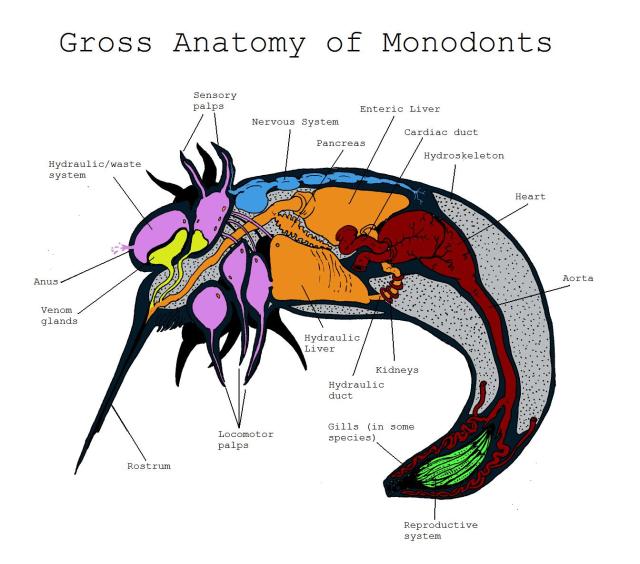
Basic Anatomy – Plicozoans always begin embryonic development by folding into a tube. In most monodonts, the tube folds around into a U before the rest of the organs develop. As a result, the gut loops around and exits through an opening above the anterior venom sac. In some species, the venom can mix with the waste to produce a noxious ejecta for warding off enemies. In species with more advanced locomotor abilities, the waste can be watered down into a fluid for the hydraulic muscles in the locomotor palps. This is separate from the hydroskeleton that all monodonts posess. To prevent metabolite toxicity, the hydraulic liver metabolizes and concentrates toxins to be ejected from the anus.
The venom sacs contain components that only become active when mixed. In the simplest case, the anterior sac secretes a zymogen (enzyme precursor) and the posterior sacs secrete an alkaline solution of various chemicals that activate the zymogen. If they were to mix within the body, the creature would be digested from the inside out. This is, appropriately enough, exactly how carnivorous monodonts deal with their prey.
The sensory palps contain all the structures necessary for olfaction, taste, and rudimentary thermal imaging. The rostrum is an excellent conductor of vibrations and sound. Parasites hone their senses to the signatures of their preferred host. Eusocial monodonts make use of their senses to maintain order in the colony. The devil’s archer bypasses the need entirely by fusing the nervous systems of neighboring units.
Pipe snakes – These intestinal parasites are the only remaining monodont without a looped gut. That is, the head and anus are on opposite sides of the body. This allows the parasite to lodge itself in the spiral intestine of certain red plant derivatives and divert the flow of digesta through its own body.
From here onward, all monodonts undergo a stage of embryonic development where the tubular embryo folds once more into a horseshoe. As a result, the anus opens right above the mouth. To prevent waste contamination, these monodonts (known as hemiansiformes, “half looped forms”) evolved a longer rostrum to put some distance between the mouth opening and the anus.
Sea Maces – The first hemiansiform monodonts probably resembled the swimming larvae of this sessile filter feeder.
Lancers – The simple design of lancers allows them to parasitize a wide variety of organisms, although a few remain predatory. The rostrum is thin and flexible.
Archers – Ossification and branching of the rostrum opened up a multitude of predatory niches. While most archers are solitary, a few eusocial, parasocial, and quasisocial species have arisen from this group. Most notable, perhaps, is the devil’s archer, a superorganism specialized to launch arrows at passing prey.
Jousts – These walking monodonts are typically parasitic of black plants and hairy animals such as starruses and other jousts. Those that choose to feed on bald animals are rather conspicuous to predators. Still, they are not defenseless. A specialized venom sac can spray a caustic substance out of the anus to ward off predators and competitors.
Trous de Loup – Also known as tiger traps, these mole-like animals can cooperate to dig pit traps for large prey. The pits do not need to be deep. Usually, once an animal has fallen in it will succumb quickly to a paralyzing venom.
Dartfish – These peaceful plankton eaters are plentiful in Ilion’s shallows and fresh water bodies. A few species, however, couldn’t shake their parasitic ancestry and have adapted to drink the nectar from buoyphytes.
Feeding Strategies
General
1. Tiger traps dig holes in the ground and wait for their prey to fall in.
2. Some monodonts predate on red plants. Because plants are biochemically similar to animals, especially red plant derivatives, the line between herbivore and carnivore begins to blur. Some of the more adaptable red plant parasites will just as readily jump on the back of a passing animal.
3. Black plants are covered in hair-like microphylls (leaves). Likewise, many black plant eaters sport a coat of fur to help them blend in. (See jousts, below)
4. Like the tiger trap, some lancers and archersnakes lie in wait for a passing animal to brush up against their venom-tipped stingers. Unlike the former, however, these cannot dig their own holes.
5. Blood parasitism suits monodonts well. After thoracostomes, monodonts are the second most common ectoparasites afflicting animals across the planet.
6. The ancestor of most monodonts was an abyssal filter feeder much like this one.
7. This intestinal parasite completely blocks the spiral intestine of a red plant derivative. Because the digesta has no other way to go, it must pass through the parasite’s own gut.
8. A powerful neurotoxin can bring down most animals, but some of the biggest starruses take a while to submit to the bite of an archersnake. The snake’s solution is to spray a pheromone into the air when it has a hold of the animal and wait for reinforcements to arrive.
9. The devil’s archer is unique among monodonts: it is a superorganism. Genetically identical individuals take on different organ functions depending on the needs of the whole. The body engulfs tree trunks and low limbs in the rainforest of Pandaros. It is capable of firing tethered arrows at passersby using a highly developed sensory system that extends into the forest floor.
Archer Parasites – Archers are a branch of monodont with an ossified, barbed rostrum. They tend to be more predatory (and venomous) than their lancer relatives, but several parasitic forms have evolved nonetheless.
1. This animal’s body blends in well with the fur of the joust it feeds on. When threatened, it can reduce blood flow to the skin to hide its thermal signature from predatory thoracostomes.
2. The above parasite itself has a parasite. The worm siphons digesta straight from the esophagus of its host.
3. If the alveoli of a clamshell lung is infested with enough of this worm, the animal will suffer from low stamina, hyperkalemia, and anemia. The disease can easily be identified by a characteristic “creaky door” sound as the lung’s bellows struggle to close.
“Ilian life is not exempt from infirmity. A wooly starrus infant we had previously tried to rescue was found dead in the shadow of Rorschach Glacier. Its herd had exiled it to prevent the spread of a lung parasite to other members of the group. The animal’s single lung was infested with a tiny, wormlike relative of archersnakes, numbering in the hundreds. Several had already exited their birthplace to feed on the carcass when we performed the necropsy. We believe the worm is a true parasite, not a parasitoid, as we determined the cause of death to be exposure rather than lung failure. Nonetheless, banishment to the unforgiving tundra is certain to make any infestation a death sentence.” – Alex O’Hearn, biologist, Odyssey II
4. The hook shape of this stomach parasite enables it to attach to the stomach wall without blocking the opening of its rostrum.
5. A single female invades a starrus’s womb through its reproductive tract to spawn. The invader then releases hormone-mimicking chemicals into the host’s bloodstream to induce pseudopregancy. The starrus will exhibit all the behavioral and physiological changes associated with pregnancy until the time comes to sheds the womb. Instead of a bouncing baby starrus, a writhing mass of snakes will exit the sack.
6. This brood parasite infiltrates the nest of a related eusocial archer. It lives a cushy life in the care of the hive’s nurses until maturity, when it will leave the hive to find a mate.
7. The shipsinker punches holes in buoyphytes to drink from the nectar inside. An invasion of these pests can devastate swaths of delicate buoyphyte habitats within weeks.
8. The brain cysts caused by this worm can lead to behavioral change, impaired development, or loss of motor control depending on location.
9. The mobile fruits of red plants are frequently taken over by parasitoid archers. Instead of germinating, the embryos will play host to the developing larvae of a predatory archer.
Lancer Parasites – Lancers are a branch of monodont with a smooth, flexible rostrum. Lancers are specialists. Almost every species has at least one lancer parasite associated with it. This has lead to a substantial diversity of species and adaptations among parasitic lancers.
1. Earpoppers enter the eardrums of wooly starruses through the auditory nerve that runs the length of their palps. This is not so devastating to six-eared species, but the swelling is painful enough to convince the victim to find a sharp object to lance the abscess. The larvae consume the pus and find their way to the nearest plant, where they will be picked up by their next victim.
2. In red plant derivatives, nutrients are absorved from the intestine directly into the liver. The liver lancer diverts these nutrients for its own use.
3. Many small creatures, like this hairy grub, have a parasitoid directly associated with it. Mature lancers enter through an orifice or directly into the skin and release their spawn. The worms mature inside and kill the host upon emergence.
4. Underminers are microscopic skin parasites that cause symptoms similar to mange.
5. Bone borers live inside the fibers of a red plant derivative’s neuroskeleton. The hollow nerve sheaths are a good home for the worm, but they do not provide sustenance. Borers must drill in and out of the fibers to access the flesh of their host. Understandably, this causes considerable damage to the animal’s skeleton.
6. Archer’s bane resides in the sensory tendrils of the devil’s archer. The infection can cause insensitivity or misfiring in the host.
7. Vascular parasites use the vascular system of black plants to reach the plants’ energy stores.
8. Unlike the liver lancer, the intestinal villus worm never made it out of the spiral intestine of its host. The rostrum is a complex filtration system to keep particulates out of the lancer’s stomach capillaries.
9. Nerve borers live in active nerve tissue. Symptoms of a nerve borer infection range widely from mild pain to seizures.
Examples
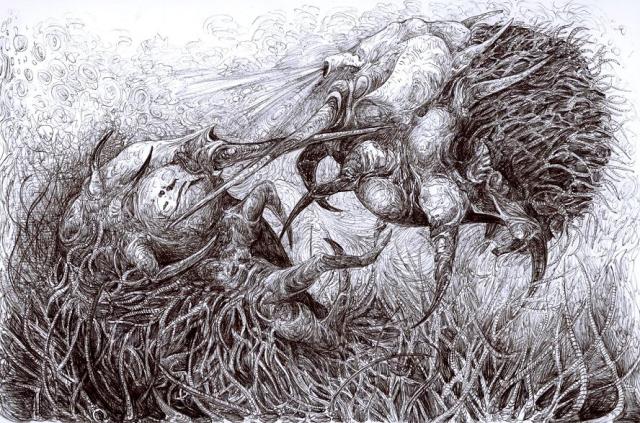
Jousts – Jousts are Ilion’s closest equivalent to aphids. They feed on black plants by injecting them with digestive fluids, waiting a bit, and slurping up the resulting soup. Preparing a patch for consumption is costly and time consuming, so each animal must continuously patrol its territory to keep out freeloaders. The individual on the left is guarding her feeding grounds from a bold interloper. She fights valiantly, but she is no match for the younger, stronger female looking for an easy meal…or, perhaps, a prime location to give live birth to her young. A quick spray of caustic venom sends the loser scurrying.
Archersnakes
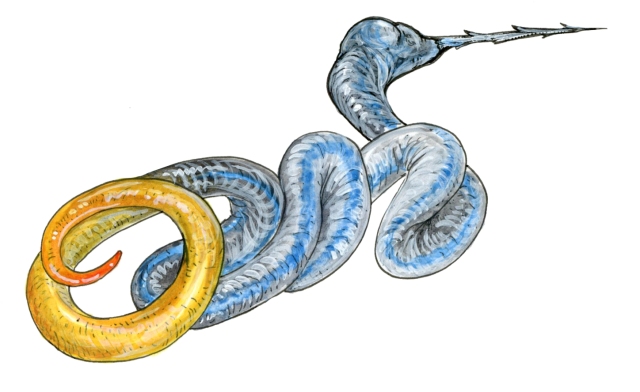
Blue sun archer. Sun archers are small, potently venomous archersnakes that hunt larger prey using a sit-and-wait method. They use their brightly colored tails to distract prey – and potential predators – while a companion moves in for the kill. After a successful strike they move out of range and wait for their prey to go down.
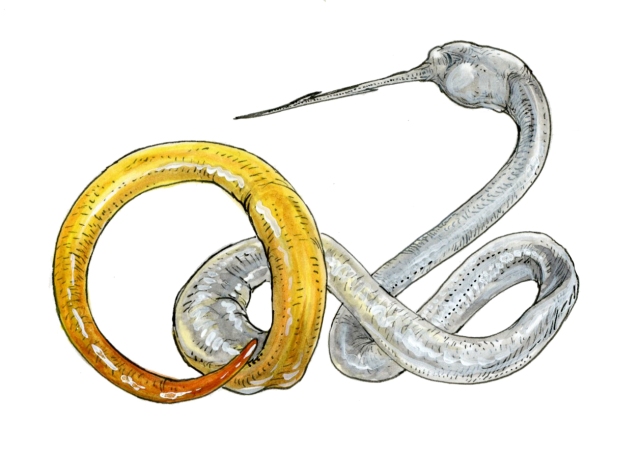
Gray sun archer
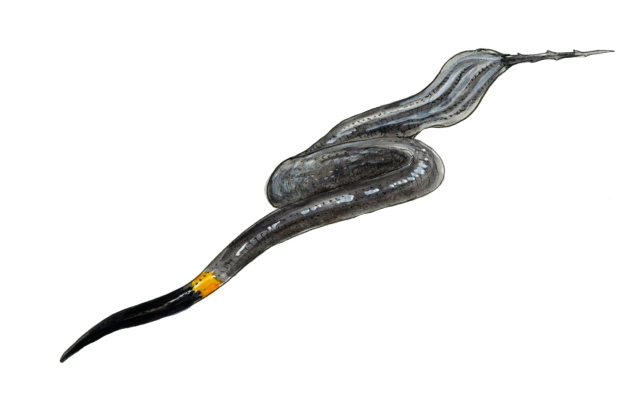
Eclipsed sun archer

Pushpin archers
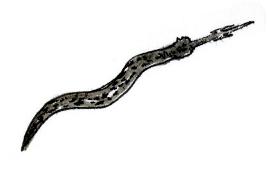
Two bladed razorwire. Razorwires hunt by nicking their prey in an artery and waiting for the animal to bleed out.
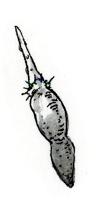
Cream-colored fatworm
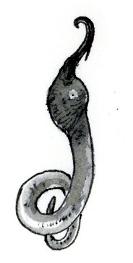
White tailed fishhook
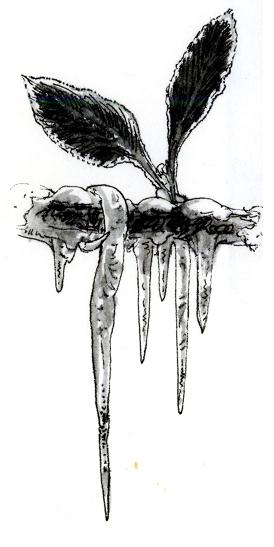
The frostbiter mimics icicles in forests with rapid freeze and thaw cycles. It was once thought that the snake uses this strategy to get the drop on its prey but recent observations indicate that the snake only hunts in warm weather. During cold spells, the frostbiter assumes position and enters a hibernatory state to conserve energy until the next thaw. Antifreeze proteins protect the snake from temperatures as low as -12 degrees C.
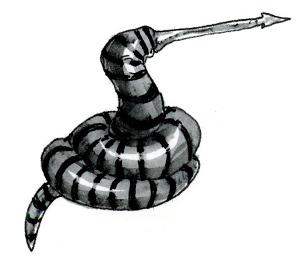
Green-banded arrowhead
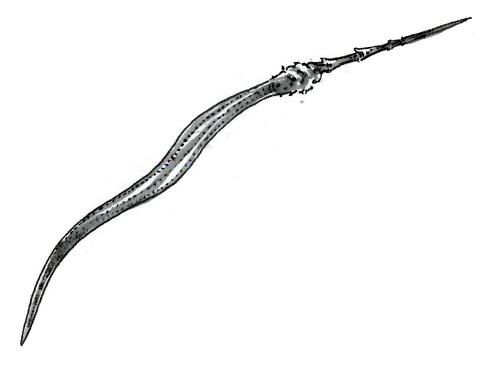
West rashland archersnake
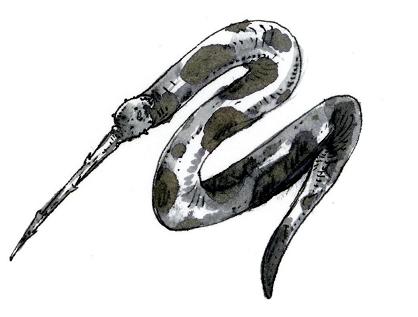
Polyxena archersnake
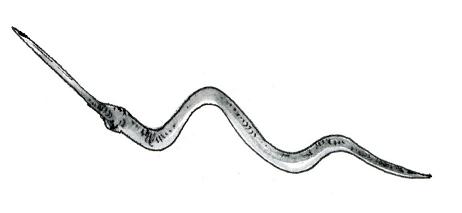
Sixteen-gauge needleworm. Like lancers, needleworms lack barbs, but they still have the ossified rostrum that defines archers. The rostrum is strong, smooth, and sharply beveled to penetrate the tough bark of black plants.
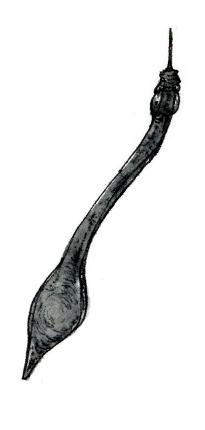
Flat tailed needleworm
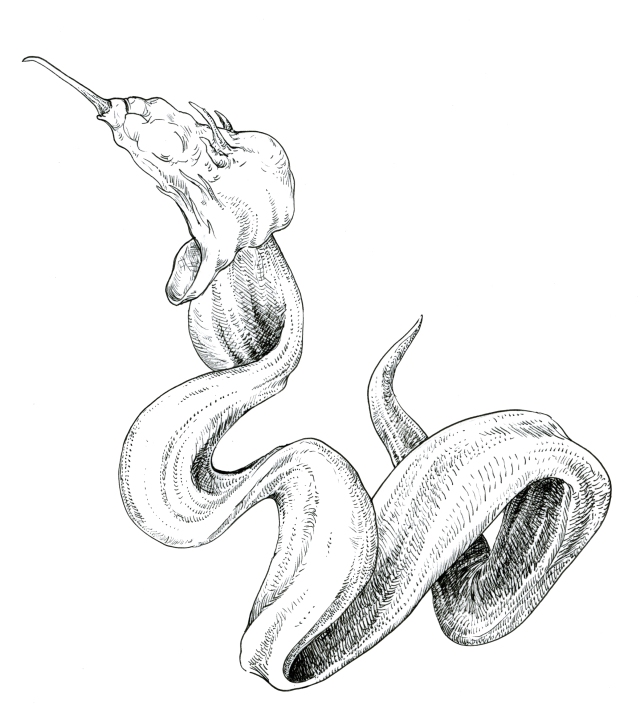
Not all archersnakes eat animals. The pitcher-catcher picker has adapted its head and rostrum to fish seeds and other debris out of the pollen pads of pitcher-catcher trees.
Reticulated arrowhead: Photo from the rover L18
 “A reticulated arrowhead took shelter under the medium-sized wheeled rover L18, Helen of Troy. The rover was exploring the Burning Rock Desert in Western Pandaros, where temperatures can climb to 40 degrees during periods of high stellar output.”
“A reticulated arrowhead took shelter under the medium-sized wheeled rover L18, Helen of Troy. The rover was exploring the Burning Rock Desert in Western Pandaros, where temperatures can climb to 40 degrees during periods of high stellar output.”
Aquatic Archers
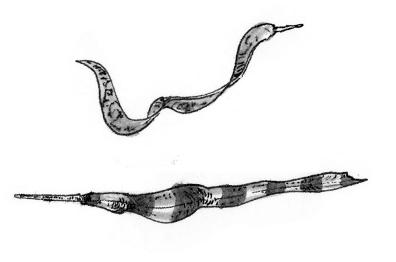
Stingerheads
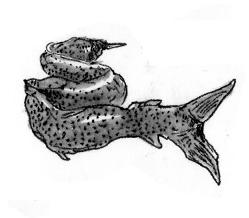
Migratory archfiend
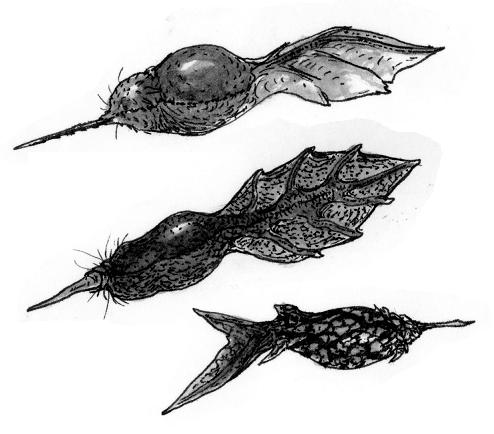
Blowdarts
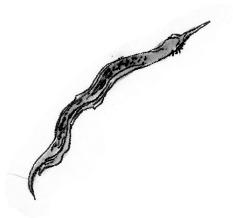
Riverpecker
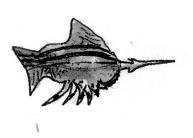
Colonial arrowfish
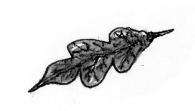
Benthic false leaf
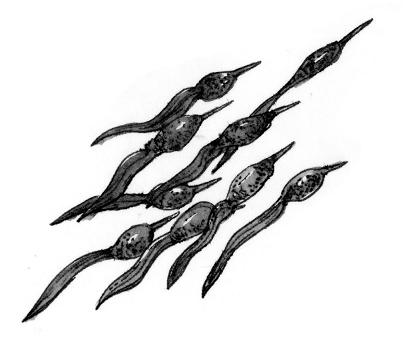
Paddywags
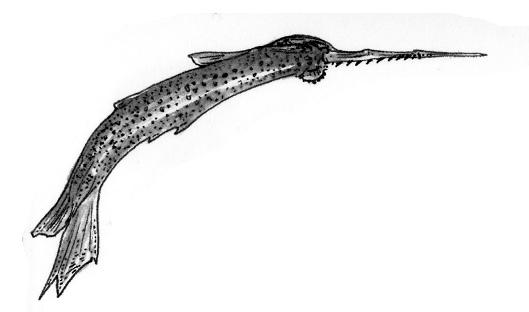
Chainsaw fish

Mottled archfiend
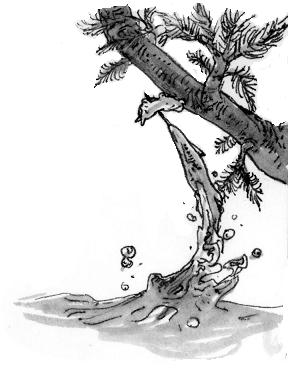
Breaching bluetail
Dagrites
Dagrites are social archers with a caste system. They are not a clade.

The green and white spitting dagrite has three castes: queen, nurse, and soldier. Nurses can induce the queen to produce different castes by raking the rasp on the queen’s head in different ways. The vibration stimulates the release of hormones which regulate the development of new offspring.
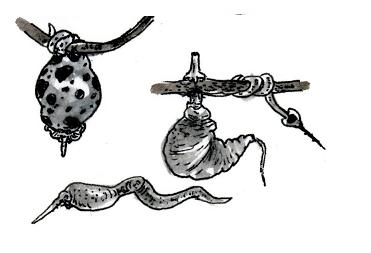
The northern fruit-of-the-vine inhabits the dense, tangled redcap forests of Deiphobus. There are four castes: replete, queen, soldier, and worker. Soldiers exist to guard the queens, which are lodged in a vine and unable to move. Repletes protect themselves with a poisonous skin and warning coloration.
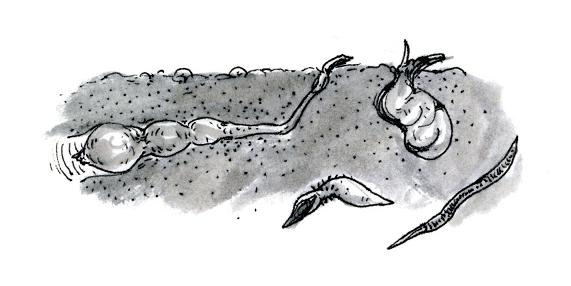
Burrowing dagrites have four castes: queen, shoveler, replete, and hunter. Repletes and queens are sessile. They protect themselves with a venomous thorn but they are still an important food source for many specialist predators.
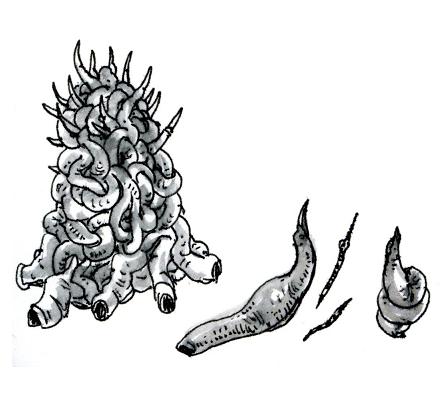
The savanna crown of thorns is famous for constructing towers out of the husks of their own dead bodies. When a worker grows too large to fit inside the tunnels, it hypertrophies and becomes part of the structure. At the center of the hive lies the queen.
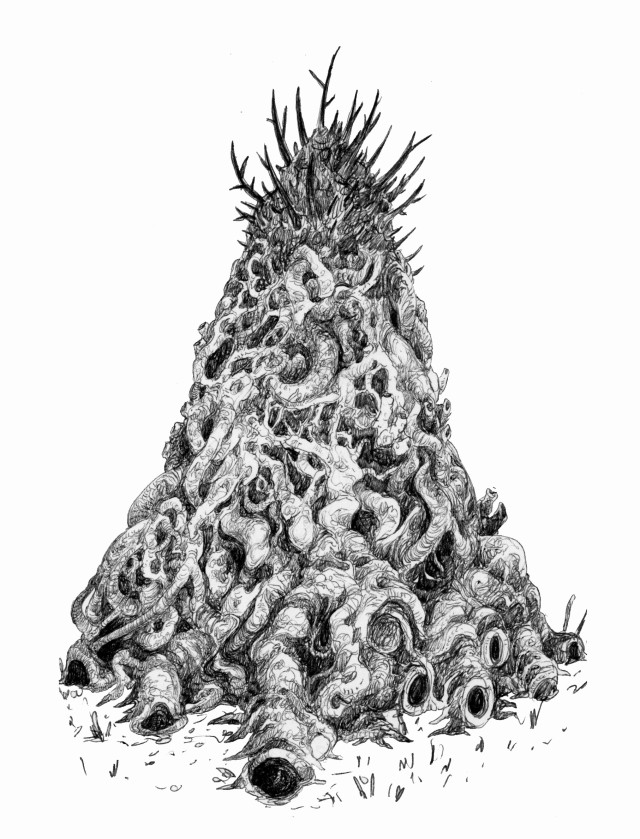
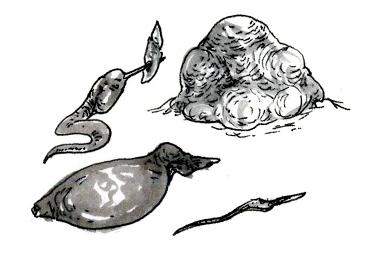
Brewer dagrites cultivate microbial cocktails in caves, open fields, or tree hollows. Monodonts have a delicate digestive system, so extraoral microbial digestion is necessary to convert plant fibers into something the animals can digest. Brewer dagrites are an important part of rashland ecosystems.
Lancers
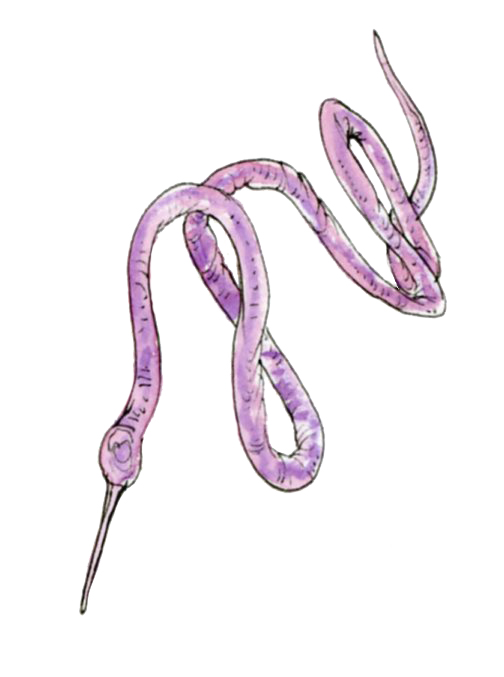
Ajax stun lancer, a tiny sea predator with a paralyzing venom
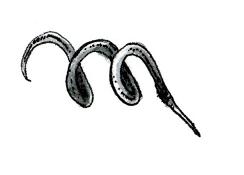
Curly fruitworm, which infests mobile fruits of the spiraform clade
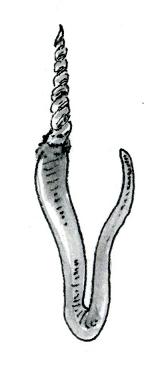
The Red Valley Lake drillbit burrows inside heavy-bodied shore plants using its hardened, spiralling rostrum. Microbes from the environment help break down the woody material to a form that the worm can safely ingest and metabolize. Drillbits and their relatives are the leading cause of necrotizing wounds in red plants.
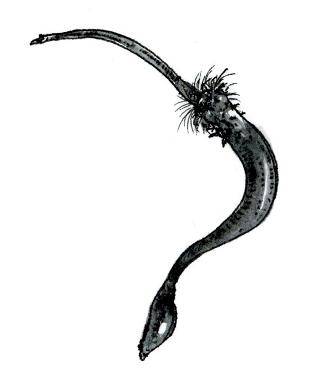
Bristle-headed gavage. Gavages have a flexible rostrum that can be inserted with surgical precision into the veins of soft-bodied red plants.

Pelican lancer, a rare suspension feeder among lancers, which are normally parasitic. The rostrum contains a complex system of filters and bristles to extract and process plankton so it can safely enter the bloodstream.
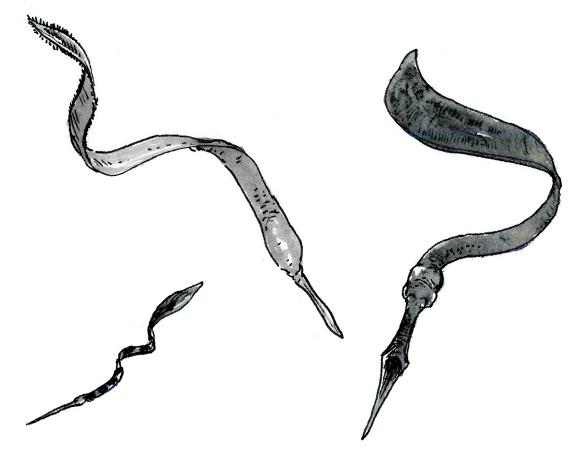
Doctor worms. These flat bodied lancers envenomate their hosts with a powerful local anesthetic. The venom also has antimicrobial properties to prevent bloodborne pathogens from crossing over to the worm’s bloodstream. Wounded animals will seek out ponds containing doctor worms to relieve pain and fight infection.
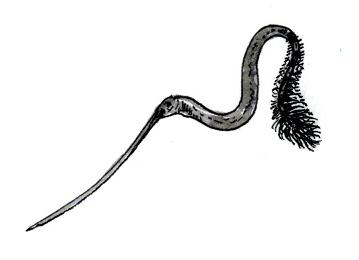
Tropical buoyphyte gavage
Devil’s archer
Devil’s archer is monodont genus that has evolved superorganismhood. It has its own page.
Polyxena Archersnake
The Polyxena archersnake was researched in depth by the Odyssey II team. Its life cycle and interactions with other species are detailed here.





